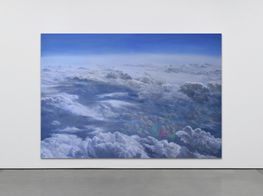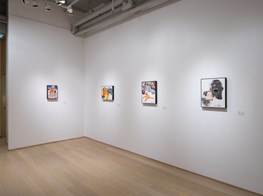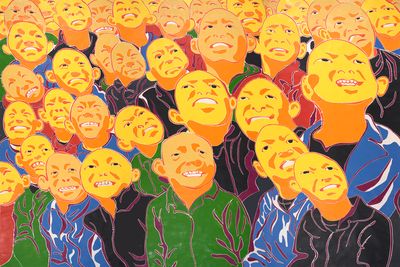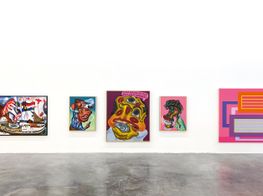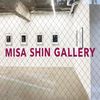Fang Lijun
Fang Lijun's immense woodblock print 2016 (2016) encompasses one wall of the artist's solo exhibition at Hanart TZ Gallery in Hong Kong, This All Too HumanWorld (3 November–2 December 2017). The work features, in Fang's bright and graphic signature style, a throng of anonymous, bald-headed figures cluttered across the picture plane. They look towards the sky, their grins evoking a sense of collective anxiety. In his trade mark use of garish colours, the artist successfully creates a tension between idealism and helplessness, a sentiment that held particular relevance when his work was first gaining international recognition in the 1990s, and finds renewed potency today. The anonymity of Fang's bald figures is, as the artist explains, a means of enabling viewers to project themselves onto the work and enter a process of self-reflection. In his most recent work, Fang has also started to frequently incorporate an infant figure, which he explains as being for the purpose of enhancing the anonymity of his subjects, further pushing viewers to project themselves onto his works.
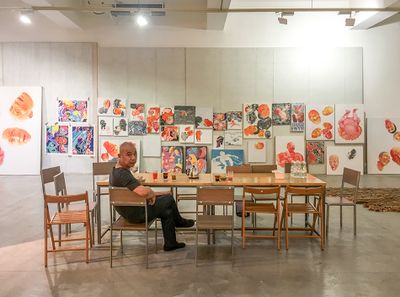
Fang Lijun. Courtesy the artist.
This All Too Human World includes a selection of 19 paintings and woodblock prints that often contrast his usual bright popping colours of yellows, greens, blues and pinks with dark browns, blacks and blues. In 2016 Autumn (2016), for example, the bruised tones of bald heads belonging to figures which crowd around a whaling infant are contrasted with the bright pink of the baby and the glaring blue of the background. In the woodblock print series '2017', colourful, grimacing faces are assembled against tones of black, blue and purple.
In this interview, Fang discusses his latest work and his desire to push his creative processes to the absolute limit.
The works that generated your international recognition in the 1990s were created in the context of socio-political turbulence in China. Along with other artists of your generation, including Liu Wei and Yue Minjun, you responded with a stylistic movement that is known as 'Cynical Realism' in the West. Do you think this term can still be applied to your most recent works or has it evolved into something else?
The term Cynical Realism was first mentioned by the art critic Li Xianting back in 1991. After he mentioned this term, people started looking at my work in this way. I've always liked mischievousness, mockery, making fun of people ... It's part of my personality, and I think that it's something that's universal and something that people can relate to when looking at my work. But I've never really attached myself to the term Cynical Realism.
Before you start a painting, are you more influenced by internal observations, or observations of your surroundings in contemporary Chinese society? Or a combination of both?
Whether it's inside, or outside, it has to start from somewhere. It's very personal, to create, and the subject matter that I use might bring suffering, or create certain feelings. These feelings are connected among people. No matter where you're from, whether you're from England, the States, Africa, China, we're all connected by empathy.
Bald figures recur throughout your paintings. In your earlier works, these figures were mostly depicted as adults, but infants seem to be more prominent in your latest works. What led you to this change in subject matter?
When I first started doing these works, I was depicting a symbolic human being. I was trying to mock people—mediocre people, with no faces, no particular features. After all these years, I found that infants are more suited to what I'm trying to convey. We were all babies, and babies all look quite alike. So instead of trying to depict a generic human as an adult, the infant is a purer symbol. It's easier to project yourself onto an image of an infant rather than adult.
These infant figures are repeatedly portrayed with adult figures towering over or surrounding them, giving a menacing feel to the paintings, a sense of being preyed upon, even. Particularly in 2013 – 2017 Summer (2017), where a baby bird is being dangled between a figure's thumb and forefinger and lifted, as if for examination. Can you talk about the feeling of helplessness in your works?
The fact that you found that painting intriguing means that you already had that intuitive reaction. As an artist it's my job to visualise my instinctive reactions to the world. These things might come from my surroundings, or the news, but I'm trying to translate these feelings as subject matter in my paintings. The work that you mentioned expresses what I feel towards the world; not necessarily in China but the whole world.
Not included in this exhibition are your incredibly fragile ceramic works. You returned to ceramics a few years ago, marking the first time you have worked with the medium since graduating from the ceramics department of the Hebei School of Light Industry in the 1980s. What led you to return to the medium?
For the ceramics, it's a process of entering extremism and pushing limits. The ceramics are extremely fragile, and often break. Creating artworks is never difficult for me, it's just a process. Rather it's the dedication that I find difficult. Creating ceramics is just a more extreme exploration of process. Jingdezhen is the centre of ceramics in China, and I think perhaps the only place in China where people are proud of being craftsmen.
Are there any craftsmen in Jingdezhen that are angered by your approach to ceramics?
A lot of people are very angry. Ceramics have a very long history in China. The art of porcelain is an art of perfectionism—only one ceramic work out of 999 might be considered a successful piece; the rest is thrown away. In the modern eye that looks like a waste. But I think, what if you look at it differently—why not throw away that one perfect piece and keep the 999 imperfect ones?
I have a lot of other friends working in Jingdezhen. Creating ceramics requires a lot of attention to detail; issues come about easily, there might be cracks, or the colour isn't right ... My friends—because of the market, or simply out of habit—like to polish and hide these defects. But that's boring to me—I don't understand the point of hiding faults in ceramics. I've tried to convince my friends but none of them listen to me, they want to make them perfect. I don't think it should be about perfectionism, but rather the meaning behind the work.
Hong Kong is currently going through an anxious time, as people grow increasingly unsure of the region's political situation. Is this something that you considered before the show? In terms of how your works might resonate with the local audience?
For me artwork is always valuable when it's honest. I don't pay too much attention to how the local audience might react to the work, it's my honest reaction to human nature in general. The feelings that I'm trying to express in my works are universal.
What are you focusing on at the moment?
My general direction is to push all of my work to the extreme. I'm working on 100 or more works at the same time currently, and in all kinds of media. I work on many works at the same time, whether that be in Chengdu, Beijing or Jingdezhen ... I spend a lot of time on the road so I don't really have enough time to think about a different way of working, just about how I can push what I am currently doing to the absolute limit.—[O]

